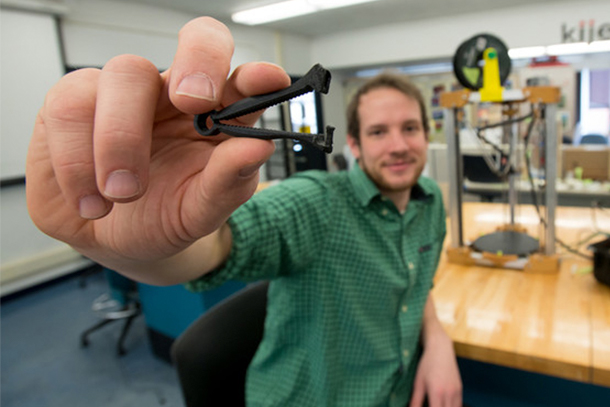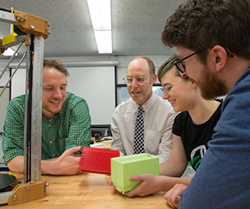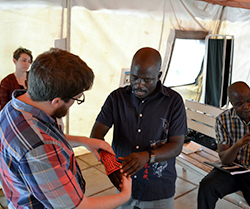
Student researchers on the Kijenzi venture team are developing a 3D printing system to boost healthcare affordability and accessibility in low-resource areas like rural Kenya.
3D Printing with a Purpose
07/19/18
Amid farmers and fishermen outside Kisumu, Kenya, a rural healthcare clinic buzzes with scientific discovery. Doctors, nurses, and medical students observe as a 3D printer transforms a digital design into a usable umbilical cord clamp. While this single tool has a limited number of uses, the potential of this technology for the community could be limitless.
For Ben Savonen, a Penn State doctoral candidate in mechanical engineering, lightbulb moments like this are what fuel his passion and what brought him to the University’s Humanitarian Engineering and Social Entrepreneurship (HESE) program. As part of the College of Engineering’s School of Engineering Design, Technology, and Professional Programs, Savonen is leading a team to research and develop a readily deployable 3D printing system designed to serve rural African healthcare facilities.
At many of these facilities, importing medical equipment, anatomical models, replacement parts, and occupational therapy devices can take anywhere from a few months to a year and can be cost prohibitive, says Savonen. Introducing 3D printing as a way to locally manufacture some of these objects could streamline the supply chain process for healthcare providers and their patients in low-resource areas.
To do this, the team developed Kijenzi (loosely translated to “little builder” in Swahili), a mobile 3D printer capable of being folded into a backpack or duffel bag and easily transportable from one healthcare facility to another. As for the parts used to build the printer itself, the team is researching ways to recycle local plastic waste to ensure the entire process can be Kenyan-sourced and built.
“We’ve been exploring the idea of installing these 3D printers in or near rural health facilities, training staff members and local entrepreneurs there how to use them, and creating the necessary support systems,” Savonen said. “If these facilities can make those hard-to-get items for themselves, they could keep running their facility the way they need to rather than having to import everything from other countries.”
Through multiple trips to Kisumu, Kenya, and its surrounding communities, Savonen and the rest of the team have been able to work side by side with local healthcare providers, gathering feedback and insight and engaging directly with community members and government entities. These entities have played an important role in co-developing the technology and will play an even larger role in launching the venture.
“Compared to most engineers, I get bored working only with technology. I like having a human component to my work,” Savonen said. “This is a very experimental project, but, as some of the components of it work out, it will have a huge impact.”
Printing Healthcare Solutions
For rural areas in Kenya, healthcare accessibility has been, and continues to be, a growing concern—one that the Kijenzi venture hopes to solve by providing accessible and affordable medical education tools.
“For too long, people have lacked access to appropriate medical care just because of where they were born,” said John Gershenson, HESE director and Savonen’s adviser. “Now, the entire world will know that Penn Staters are helping to right that wrong.”
In 2014, Kenya’s physician-to-population density was one physician per 5,000 Kenyans, according to the World Health Organization. (For comparison, the United States had an estimated 12.84 physicians per 5,000 patients in 2014.) And while the Kijenzi venture is still in its early stages, introducing affordable and accessible 3D-printed lab and medical equipment has potential to encourage future generations of healthcare providers and scientists.
“A lot of times, medical students in these communities don’t have access to the tools necessary to have a complete understanding of what they’re learning,” Savonen said. “These 3D-printed anatomical models can be used not only for students in labs learning the parts of the body, but also as practice tools for surgeons.”
Savonen experienced this lack of resources firsthand while teaching science in Tanzania on behalf of the Peace Corps. For many of Savonen's young students, engaging with hands-on science education tools like labs and experiment equipment was never a reality.
“I’m a firm believer that you can’t learn science out of only a book, and if you do, you’ll probably hate it,” Savonen said. “Most of the time in these communities, books are all they have, and they might not have money to afford a lab or equipment.”
Drawing on Penn State Expertise
Kijenzi is one of many emerging ventures housed within the HESE program, which, according to Gershenson, aims to apply Penn State research and expertise in ways that solve real-world problems.
“We’re developing Penn State students into people who change the world,” Gershenson said. “We give them the tools and methods they need to have real impact, specifically, on underserved communities around the world.”
Other HESE ventures include turning invasive plant species into new fuel sources, developing a transparent way to link rural farmers with the markets they serve, and providing modular 3D printers to humanitarian relief organizations.
While the idea for Kijenzi originated outside of Penn State, the team soon realized the need for further resources to continue to build and develop the concept. That’s where the University’s vast network of experts and resources proved invaluable.
“We moved to Penn State because of the access to 100,000 students and 17,000 academic faculty and staff who can multiply our project’s reach,” said Gershenson. “This is really a university of amplification, and the knowledge generated across campus with students, faculty, and staff is absolutely phenomenal.”
Some of the many resources the project has benefitted from include experts in 3D printing, legal support from faculty members in Penn State’s Dickinson School of Law, as well as cultural insight from the Africana Research Center. Team members on the Kijenzi project represent a diverse group of colleges and disciplines, including the College of Engineering and the College of Information Sciences and Technology.
Cultivating Future Change
While the work done so far has helped move Savonen’s idea closer to reality, he hopes that Kijenzi will continue to add to the Penn State entrepreneurial ecosystem for years to come.
“I’m hoping this research is never finished,” Savonen said. “My goal is that even after I get my piece of paper saying I have a doctorate and hopefully form a team to take Kijenzi to scale, the students of HESE can benefit from what we learn and the new problems we encounter. This will lead to new ventures coming out of the program.”
For Gershenson, Penn State and the HESE program are the perfect environments to cultivate projects built on empathy, understanding, and collaboration.
“Having a global impact doesn’t start with technology, solutions, or business models. It starts with people and getting to know them and their problems or challenges,” Gershenson said. “Imagine how Penn State can change the world if we operate by launching students with that mindset.”




